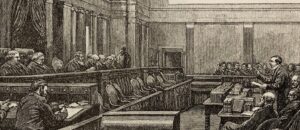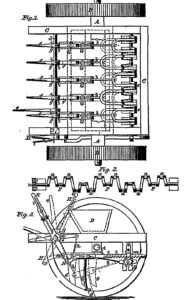
An attorney arguing before the Waite Court in 1881. In patent cases, the machines would have been operated in front of the bench. Credit: Harper’s New Monthly Magazine, March 1881, p. 555. Image #2. Drawing of a grain drill by Charles F. Davis submitted in the brief in his 1886 patent case. Brown v. Davis, 116 U.S. 237 (1886).
Courtroom spectators during the Chase and Waite Court eras were often surprised to see the justices leaning over the bench to get a better view of how a mechanical device operated. In patent infringement cases, counsel would arrange for brawny men to lug heavy contraptions into the chamber so the justices could make their determination of novelty. They observed counsel demonstrate devices such as hat-makers, flour mills, steam safety valves for boilers, seed distributors, liquor casks seals, well construction equipment, drilling machinery, and knapsack designs. The justices asked technical questions and handled machine parts. Huge sums of money often rode on the Court’s decision. While no sketches exist of these lively interchanges between bench and bar about these new technologies, written accounts fire the imagination.
In an 1864 patent case, for example, a reporter recounted how attorney George Harding orchestrated a fur hat-making session to prove that his client’s cone-shaped mold did not infringe on an earlier patent:
“In the hat body-machine case to-day in the Supreme Court, Harding, of Philadelphia, closed his argument. He illustrated it impressively by making hats from fur cut from skins right in court, in the short space of two minutes. Six [Black men] drove the different machines, while the nine gowned Judges leaned over their benches among the most interested of the spectators.”[1]
Courtroom demonstrations of these devices resembled an episode of Shark Tank more than the typical nineteenth-century show of dueling oratory. Or a university classroom with a professor in front of a blackboard teaching students. With two hours allotted per side (after 1871) there was ample time for show and tell. According to a Courtroom observer in 1882:
“In patent cases, models of machinery are frequently used to illustrate an argument, and are handed up to the judges for examination, or a blackboard is used for diagrams. Were it not for the gray hair and black gowns of the judges, you might almost imagine at times that the gentleman at the blackboard, with crayon in hand, was a college professor lecturing to a class. Or you may happen in when a lawyer in charge of a case is leaning over the long desk in front of the judges, holding a conversation with one of them on some intricate point in a mechanical device, and you would hardly think that the court was in session and that the conversation was the plea in a patent case involving perhaps a million of dollars.” [2]
The case of Brown v. Davis (1886) illustrates the challenge the justices faced. A “dozen muscular men” brought a drilling machine for grain “that had been in actual use upon some farm” into the Courtroom.[3] The patent seeker’s brief stated that the “object and purpose of my invention are to shift or change the seeding shoes or hoes from a straight to a zigzag line to make an improvement in grain drills.” That language was clear enough, but the technical drawing (see below) and accompanying text were not as easy to comprehend. This snippet of the patent’s description shows how technical the text could be:
“In bearings, E, in the front portion of the main frame, is hung, so as to rock or turn therein, a zigzag or crank shaft, F, (shown detached in Fig. 2,) and to the cranks or wrists, a, a, a, of this shaft are connected, seriatim, the drag-bars, b, b, b, by means of bows or yokes, c, each bow or yoke taking two of said wrists, as shown in Fig. 1.” [4]
Even if they were subscribers to Scientific American, the justices would have had a hard time envisioning how the devices worked and grasping if they were truly novel without a demonstration.
These “silent witnesses,” as one observed called the patent devices, ceased appearing in the Courtroom after the creation of the Courts of Appeals in 1891 and the Supreme Court no longer reviewed routine patent cases.
Notes:
[1] “Manufacture of Hats in Court,” New York Times, Feb. 18, 1864.
[2] E.V. Smalley, “The Supreme Court of the United States,” The Century Magazine, Dec. 1882.
[3] Evening Star, “A Silent Witness in the Supreme Court,” Dec. 17, 1885.
[4] Brown v. Davis, 116 U.S. 237 (1886). Argued December l7, 1885, decided January 11, 1886.





